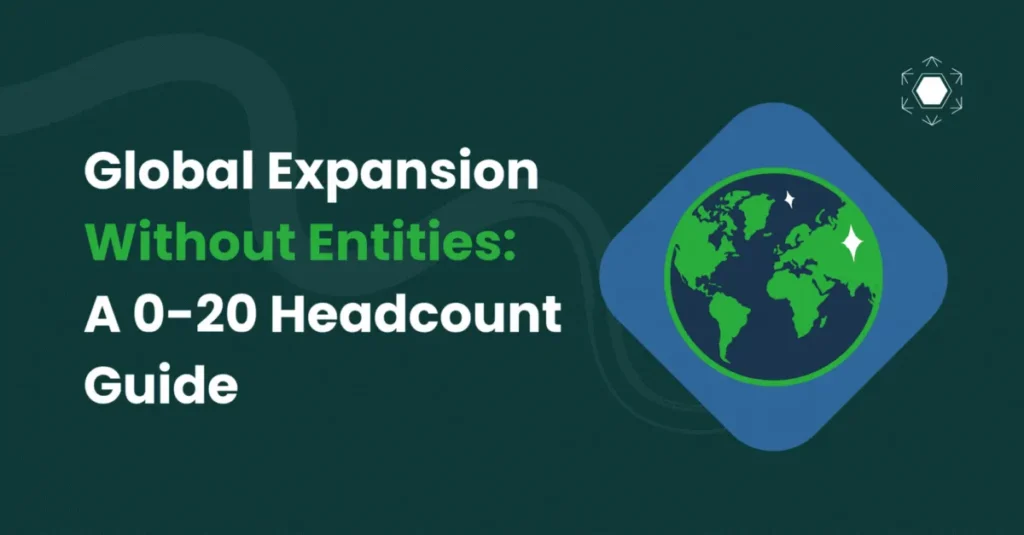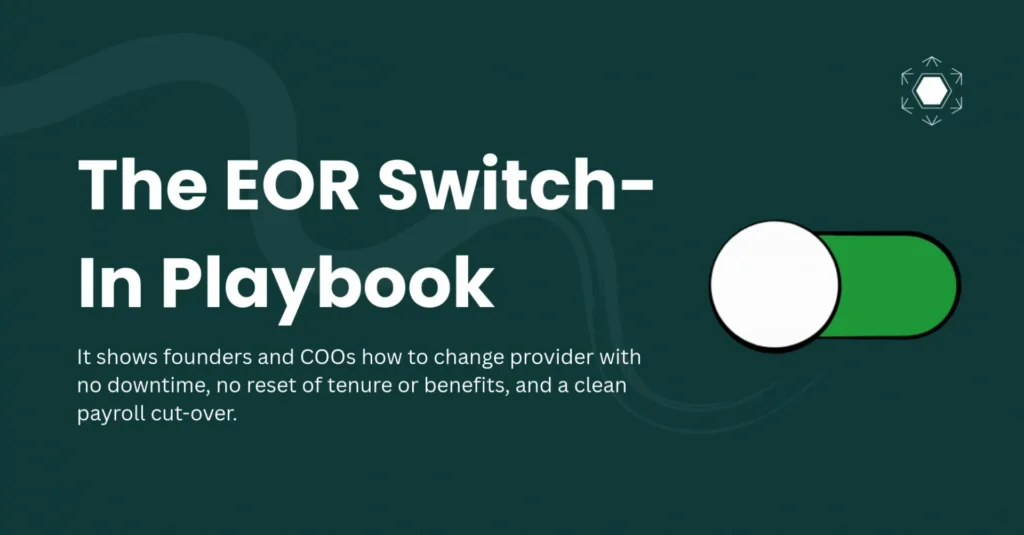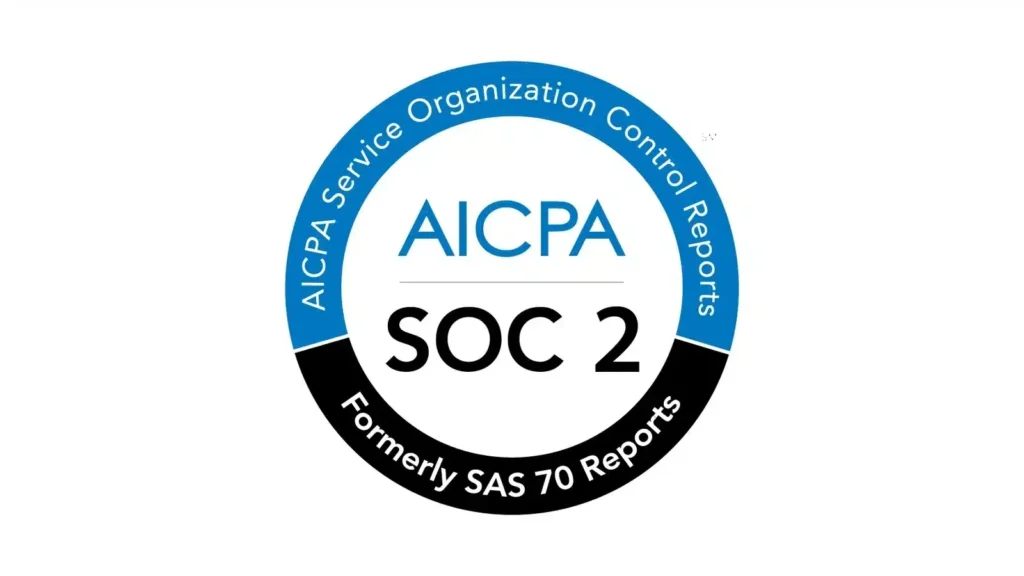When you’re exploring a new country, the riskiest move isn’t moving too fast—it’s locking in fixed costs before you’ve proven demand. In 2025, the winning motion for founders and CFOs is entity-light: hire legally via an Employer of Record (EOR), learn quickly over 90 days, then decide whether to scale, graduate to a PEO or entity, or pivot. This playbook shows you how to do exactly that—without sacrificing compliance, culture, or control.
If you need to hire internationally without an entity, use EOR to place employees on compliant local contracts with payroll and benefits in roughly 2–4 weeks. Run a focused 90-day test across one to six countries. Graduate to a PEO or entity when you’re approaching 10–20 heads in a single market, demand is stable, or permanent establishment (PE) risk is rising.
Why Entity-Light Beats “Set Up Then Hire” in 2025
Entity-first expansion creates fixed costs, delays, and dissolution headaches. Discover why EOR-led hiring gives founders and CFOs speed, compliance, and flexibility in testing new markets.
Setting up subsidiaries first made sense when market entry was slow and linear. Today, go-to-market is more like controlled experimentation. Entity-first introduces incorporation fees, bank accounts, directors, payroll registration, and months of admin before the first hire lands. If the plan changes, you’re left with dissolution costs and sunk time.
Entity-light changes the POA. With EOR, you onboard employees on day-one-ready, country-specific contracts, run payroll compliantly, and deliver statutory and agreed benefits—all without creating a local entity. That buys you the two things early expansion needs most: speed and optionality. It’s not anti-entity; it’s prove first, invest second.
The 90-Day Market Test Blueprint for Global Expansion
Learn how to validate new markets over 90 days with clear milestones for talent, compliance, and commercial signal.
A good market test is not a loose trial; it’s a structured sprint with clear decision gates. Think of it in three tracks that run in parallel: people, compliance, and commercial learning.
Talent Map, Comp Bands, and Time-Zone Coverage
Start with the market itself. Build a compact talent map—the roles you need, where those people currently work, the communities they belong to, and the channels you’ll use to reach them. From that map, set country-specific compensation bands (base, bonus, equity) tied to local medians and your internal levelling. Define how this team will cover time zones and hand off work to existing functions; nothing kills signal faster than isolation.
Structure your interviews with role scorecards so every conversation tests the same competencies. You’re not just hiring; you’re learning what “great” looks like in that market.
EOR Onboarding and Benefits Parity
Once you’ve identified hires, move fast and correctly. Your EOR will issue local contracts with the right probation, notice, IP assignment, and confidentiality language, then run payroll and enrol benefits. Aim for benefits parity with HQ where feasible—health cover, allowances, and leave policies—so your new team feels part of one company, not a bolt-on office.
Parallel to paperwork, set 30/60/90 plans for each hire. That clarity keeps momentum high and gives you crisp data at the decision point.
Milestones to Graduate or Pivot
Give yourself three honest checkpoints:
- Day 30: Have we hired on pace? Are there early pipeline or customer-discovery signals? Any red flags on comp, supply, or candidate quality?
- Day 60: Are leading indicators turning into real opportunities or revenue? What’s CSAT or early user feedback telling us? Is the team operating cleanly across time zones?
- Day 90: Choose. If demand is concentrated in one country and scaling, consider graduating to a PEO or entity. If demand is multi-country or still variable, keep the EOR model and extend the test. If the thesis isn’t there, pivot—no dissolution required.
Risk Controls to Set from Day One
Protect your IP, data, and compliance posture with strong contracts, clear data handling, and permanent establishment monitoring.
Legal hygiene is a feature, not a tax. Start with contracts that reflect local norms: IP assignment and confidentiality that protect your inventions and data, probation and notice periods that reflect statute and practice, and any post-termination restrictions that are actually enforceable.
Document your data handling—tools used, access levels, and retention—so employee and customer data stay in bounds. Monitor permanent establishment (PE) exposure: sustained revenue-generating activity, a fixed place of business, or local authority to bind the company can trigger tax nexus. If you’re approaching those lines, it’s a sign your test is working—and that it’s time to graduate your structure.
Finally, avoid misclassification. If someone is functioning like an employee, they should be employed—via EOR in test mode—rather than papered as a contractor. For nuanced questions or bespoke clauses, bring in Founders Law (link: /partners/founders-law) early so nothing slows you at Day 60.
Finance Guardrails for Global Hiring
Build financial discipline into your market test with clear cost models, FX buffers, and break-even thresholds before committing to an entity.
Treat cost modelling like an experiment budget. Your all-in figure should include gross salary, employer social contributions and taxes, benefits, EOR fees, tools, and a sensible FX buffer. Map those costs to your three checkpoints so you can compare plan vs actual each month.
The break-even question is simple: in a single country, at what headcount and time horizon do entity costs undercut EOR? For many teams, that’s somewhere around 10–20 heads with a stable 12–24-month forecast. If you expect that density, plan your graduation path now so you can execute quickly when you hit the threshold. If your demand is spread across multiple countries or still spiky, the variable nature of EOR will usually preserve more runway.
Case Studies: How High-Growth Teams Expanded Without Entities
Qualtrics, ShippyPro, Exterro, and Fiska all used an Employer of Record to scale quickly, validate markets, and preserve capital before entity setup.
Patterns matter more than one-offs. Here are four we see repeatedly at Emerald:
- Qualtrics used Emerald to assemble 40+ hires quickly across regions, building coverage without tying up capital in multiple entities before the model was proven.
- ShippyPro made 3 hires in France after switching from another provider to speed time-to-hire and tighten compliance.
- Exterro added 3 hires across Dubai and Estonia via EOR, consolidating operations after a switch-in for service quality.
- Fiska placed 4 hires in the US to validate market fit before investing in heavier infrastructure.
In each case, EOR wasn’t the destination. It was the on-ramp—proof first, then the right long-term structure.
From Test to Scale: When to Move to a PEO or Entity
Graduation is a success signal. Here’s how to switch cleanly from EOR to a PEO or local entity with StratusHR and Founders Law.
Graduation is a success signal. Consider moving when most of the following are true: your forecast shows concentrated demand in one country; you’re approaching 10–20 local heads; you need local invoicing, credit, or tender eligibility; or your activity profile is flirting with PE.
The cleanest switch has five steps. First, plan: decide between PEO (co-employment) or your own entity based on time horizon and control needs. Second, paper: prepare new local contracts that preserve IP and benefits continuity. Third, payroll: align payroll cut-over dates and reconcile accruals so nobody misses a cycle. Fourth, people: communicate early—comp and benefits should feel continuous, not reset. Finally, provider handover: coordinate a structured EOR → PEO/entity handoff. We work alongside StratusHR for PEO transitions (link: /partners/stratushr) and with Founders Law on the legal side to make the move boring—in the best way.
FAQs: Hiring Internationally Without a Local Entity
Can we hire employees abroad legally without a company?
Yes. Through an Employer of Record, your employee signs a compliant local contract, is paid locally with statutory benefits, and you operate without a subsidiary. See EOR Services (link: /services/eor).
How fast can we onboard with EOR?
Most markets complete in 2–4 weeks once terms are agreed, KYC is finished, and the candidate has signed. Immigration needs or additional checks can extend timing. Our Talent Acquisition team (link: /services/talent) can run sourcing in parallel.
What triggers permanent establishment risk?
Red flags include a fixed place of business, sustained local revenue activity, or authority to contract in-country. If your test is working and you’re edging near PE, that’s your cue to graduate structure.
How do we maintain culture across test markets?
Parity matters. Mirror HQ benefits where feasible, onboard with intention, and run consistent 30/60/90 plans and leadership touchpoints. Culture is the cadence of how you work, not an office postcode.
Next step
Design your market test with someone who’s done this at scale.
Book a 30-min market test design or grab the tools below and start today.




